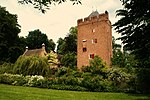The Lower Rhine (German: Niederrhein, pronounced [ˈniːdɐˌʁaɪ̯n] (listen); kilometres 660 to 1,033 of the river Rhine) flows from Bonn, Germany, to the North Sea at Hook of Holland, Netherlands (including the Nederrijn or "Nether Rhine" within the Rhine–Meuse–Scheldt delta); alternatively, Lower Rhine may refer to the part upstream of Pannerdens Kop, excluding the Nederrijn.
Almost immediately after entering the Netherlands, the Rhine splits into numerous branches. The main branch is called the Waal which flows from Nijmegen to meet the Meuse; after which it is called Merwede. Near Rotterdam the river is known as Nieuwe Maas, and becomes the Nieuwe Waterweg flowing into the North Sea at Hook of Holland.
The downstream Lower Rhine is a low lying land. Up to the beginning of industrialization roughly one fifth of the land area could only be used as pasture: an endless meadow, which could not be farmed because of flooding and a high ground-water level. However, the remaining soils of the Lower Rhine were always very fertile. That can also be seen in the farmsteads. The houses are relatively large, with the intention of accommodating a plentiful harvest and many cattle. The Nederrijn refers to the more northern former main branch of the Rhine, which flows past Arnhem; splits off the IJssel which flows into the IJsselmeer and then splits into the Lek and the Kromme Rijn at Wijk bij Duurstede. The Lek flows into the Merwede. The Kromme Rijn continues past Utrecht, becomes the Leidse Rijn, then Oude Rijn and flows into the North Sea at Katwijk.
There are other minor branches such as the Vecht, Hollandse IJssel and the Noord.
The German term Niederrhein refers both to the German section of the Lower Rhine as well as to parts of the surrounding Lower Rhine region.











